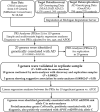Genetic correlations between Alzheimer's disease and gut microbiome genera
- PMID: 37002253
- PMCID: PMC10066300
- DOI: 10.1038/s41598-023-31730-5
Genetic correlations between Alzheimer's disease and gut microbiome genera
Abstract
A growing body of evidence suggests that dysbiosis of the human gut microbiota is associated with neurodegenerative diseases like Alzheimer's disease (AD) via neuroinflammatory processes across the microbiota-gut-brain axis. The gut microbiota affects brain health through the secretion of toxins and short-chain fatty acids, which modulates gut permeability and numerous immune functions. Observational studies indicate that AD patients have reduced microbiome diversity, which could contribute to the pathogenesis of the disease. Uncovering the genetic basis of microbial abundance and its effect on AD could suggest lifestyle changes that may reduce an individual's risk for the disease. Using the largest genome-wide association study of gut microbiota genera from the MiBioGen consortium, we used polygenic risk score (PRS) analyses with the "best-fit" model implemented in PRSice-2 and determined the genetic correlation between 119 genera and AD in a discovery sample (ADc12 case/control: 1278/1293). To confirm the results from the discovery sample, we next repeated the PRS analysis in a replication sample (GenADA case/control: 799/778) and then performed a meta-analysis with the PRS results from both samples. Finally, we conducted a linear regression analysis to assess the correlation between the PRSs for the significant genera and the APOE genotypes. In the discovery sample, 20 gut microbiota genera were initially identified as genetically associated with AD case/control status. Of these 20, three genera (Eubacterium fissicatena as a protective factor, Collinsella, and Veillonella as a risk factor) were independently significant in the replication sample. Meta-analysis with discovery and replication samples confirmed that ten genera had a significant correlation with AD, four of which were significantly associated with the APOE rs429358 risk allele in a direction consistent with their protective/risk designation in AD association. Notably, the proinflammatory genus Collinsella, identified as a risk factor for AD, was positively correlated with the APOE rs429358 risk allele in both samples. Overall, the host genetic factors influencing the abundance of ten genera are significantly associated with AD, suggesting that these genera may serve as biomarkers and targets for AD treatment and intervention. Our results highlight that proinflammatory gut microbiota might promote AD development through interaction with APOE. Larger datasets and functional studies are required to understand their causal relationships.
© 2023. This is a U.S. Government work and not under copyright protection in the US; foreign copyright protection may apply.
Conflict of interest statement
The authors declare no competing interests.
Figures




References
-
- 2022 Alzheimer’s disease facts and figures. Alzheimer's & Dementia. 18(4), 700–789. 10.1002/alz.12638 (2022). - PubMed
-
- Nichols E, Steinmetz JD, Vollset SE, Fukutaki K, Chalek J, Abd-Allah F, et al. Estimation of the global prevalence of dementia in 2019 and forecasted prevalence in 2050: An analysis for the Global Burden of Disease Study 2019. Lancet Public Health. 2022;7(2):e105–e125. doi: 10.1016/S2468-2667(21)00249-8. - DOI - PMC - PubMed
Publication types
MeSH terms
Substances
Grants and funding
LinkOut - more resources
Full Text Sources
Other Literature Sources
Medical
Miscellaneous

